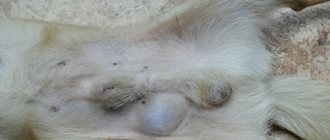Many of us have pets. In about a quarter of cases they are dogs. Moreover, these statistics take into account hamsters, parrots, fish, and all sorts of exotic things like huge spiders, crocodiles, snakes and monitor lizards. So the problem of finding a lump on a dog’s paw is familiar and close to a huge number of people. And it invariably causes them at least anxiety, and even panic. No wonder: we all believe in the best, but prepare for the worst. Moreover, a photo of a lump on a dog’s paw sometimes causes real horror with its ugliness. It is clearly worthwhile to figure out how justified it is.
Let's clarify the terminology
What is a lump on a dog’s body, including its paw? This is a lump that protrudes the skin. It can vary in size, sometimes reaching a couple of millimeters in diameter, sometimes growing to several centimeters. Sometimes the lump “walks” under the skin, shifting when pressed with a finger. The coloring of the new growth can also be different, masquerading as the color of the coat or taking on a provocative pink or frightening red tint.
Even the most experienced veterinarian will not be able to understand at one glance what causes the swelling - there are a huge number of reasons for its occurrence. Let's look at the most common ones.
Main symptoms
There is no single clinical picture for bumps on a dog’s body, since they can be caused by different diseases, each of which has its own characteristic signs.
So, with an abscess that occurs under the influence of a bacterial infection that enters the body through a bite, puncture wound or scratch, the dog experiences swelling, fever, and pain. The lump swells for several days, after which it begins to fester.
Smooth-haired dogs often develop papillomas and warts on their bodies. The cause of their occurrence is considered to be a viral infection. The growths on the skin are usually brown in color and are painless, but it is still worth consulting a veterinarian.
The dog may develop a hematoma as a result of bruises or fluid accumulation when blood vessels are damaged during surgery. It is a formation that changes the shape of the part of the body where it is located. It does not cause discomfort to the dog, however, if the hematoma does not go away for a long time, consultation with a specialist will also be required.
A cyst can appear anywhere: both on the body and on the dog’s face, for example, at the junction of the jaws. Upon inspection, it is quite easy to detect. It appears as reddish, painful abscesses that the dog tries to lick.
Pyoderma is a purulent inflammation of the skin in dogs, which is accompanied by a rash and papules. Swellings can form all over the body, paws, in folds of skin, and on the face.
Insect bites (bees, ticks and even mosquitoes) can cause painful swelling. The most dangerous bites are to the face and mouth.
There are two types of tumors in dogs: benign and malignant. Benign tumors grow slowly and, as a rule, do not cause discomfort to the dog. Unlike malignant tumors, they do not metastasize. However, this does not mean that they do not pose a danger to the health of the animal, since over time they can degenerate into cancer.
Malignant tumors appear as a result of cell mutation. Cancerous tumors are characterized by rapid growth, absence of symptoms at the initial stage, and metastases. Sometimes the bumps break through the skin and bleed. As the disease progresses, an increase in symptoms is observed.
Almost innocent
A lump on a dog's paw can form as a result of a primitive insect bite. Most often - wasps, bees, hornets or ticks. Fortunately, allergic reactions to such exposure are usually limited solely to the formation of swelling. It may be accompanied by fever, but in most cases, contact with the aggressor is experienced independently and without the need for medical intervention.
This also includes minor injuries received during a walk or as a result of disagreement on certain issues with another representative of the dog tribe. The swelling may not be accompanied by wounds and scratches - it’s just a hematoma that will resolve over time.
What is bursitis of the elbow and knee joint in dogs and puppies?
Bursitis is an inflammation of the lining of the bursae around the elbow, knee, or hip joints.
A bursa or synovial bursa is a cavity filled with synovial fluid. It softens friction in joints.
The causes of the disease may be:
- injuries
- excessive load
- inflammation of adjacent tissues
- infection
The dog becomes less mobile and irritable due to constant pain.
Bursitis in a dog
Elbow bursitis is more common . It can be painless. A lump appears on the animal’s elbow, which does not cause much concern.
Knee bursitis is more dangerous .
The disease comes in different types:
- spicy
- chronic
- aseptic
- purulent
Large breeds are more susceptible to it. Excess weight creates additional stress on the joints.
Large dogs are more susceptible to bursitis
A little more complicated
Sometimes a lump on a dog’s paw is an ordinary papilloma or wart. Smooth-haired breeds are especially prone to them, and such formations tend to multiply with age. Scientists have not yet figured out the reasons that cause increased wartiness, although they are inclined to blame it on the introduction of viruses into the body in combination with the reduced immunity of this very organism. As long as the papilloma does not increase in size and does not cause pain upon palpation, there is no need to worry about its appearance. If pain and expansion in volume are observed, this is a reason to consult a veterinarian.
Diagnosis by the appearance of the lump
But in home and similar conditions, it is still more advisable to diagnose by the appearance of the lump. It is often not so easy to guess the nature of a neoplasm, but a simple visual examination of it can provide a lot of valuable information. Particular attention should be paid to color, as well as important distinguishing signs (severe pain, bleeding, etc.).
Red
If the lump is red, then this is typical for:
- Formations of inflammatory etiology (they are characterized by pain and mild swelling).
- Some benign tumors.
- Reddened “bump-like” swellings may be the result of insect bites.
- It is possible that this is a hematoma.
- Possible abscess in the maturing stage.
Pink
In cases where the bump is pink, there are also several options for its formation:
- Benign tumor.
- Cyst.
- A type of papilloma (in principle, this is the same benign tumor).
Black
But a black lump is not very good. The reasons for its formation may be:
- Malignant tumor.
- If the lump is soft and not painful, it looks like a large papilloma or wart.
- It is possible that this is an old hematoma.
The lump is bleeding
It is advisable to visit the veterinarian as soon as possible even in cases where the lump is bleeding. This behavior is typical for:
- Malignant tumors.
- A bump of a traumatic nature (for example, a dog got hit by a bicycle).
- Sometimes benign neoplasms bleed.
- Although this is unlikely, this happens with some snake bites.
Purulent lump
Everything is very simple here, since there is almost a 100% chance that a purulent lump is an ordinary abscess. However, there is some possibility that this is a malignant tumor, so it is worth visiting a veterinarian in any case.
Lump between fingers
As we wrote above, bumps between the fingers are often cysts. This is also indicated by the dog’s unhealthy desire to lick the affected areas all the time.
As we already wrote above, neoplasms in these places can be the result of fungal pathologies. In both cases, we recommend contacting a veterinarian.
Cone without hair
If the cone is hairless, then this is a sign of its long existence. In a couple of days, the hair on the new growth will definitely not fall out. Such signs may indicate a bone growth, an old hematoma that subsequently healed, or a benign tumor.
Its consistency can also provide a lot of information about the nature of the neoplasm.
Soft or watery
So, a soft or watery lump may be:
- "Young" hematoma.
- An old and fully formed abscess.
- Release of synovial fluid into soft tissues.
Hard, dense
When the lump is hard and dense, this may indicate:
- Malignant or benign tumor.
- Traumatic swelling.
- Bone growth or bone cancer.
- An old hematoma or abscess in the stage of petrification (petrification) or scarring.
Lump on a joint
If there is a lump on the joint, it could be:
- Traumatic destruction of the joint capsule and release of synovial fluid.
- A tumor.
- Arthritis or arthrosis.
What if your dog has a bump on his paw between his toes?
A very common problem called pododermatitis. The owners notice that the pet is having problems by diligently, frequently, almost doing it on the go, licking the pad. Upon closer examination, it is revealed that the membrane between the fingers has turned red, remains constantly wet and bulges. If nothing is done, the skin begins to ulcerate and fester. The further, the worse: pododermatitis can affect all limbs, and the dog will barely walk, limping on all four legs at once.
The saddest thing is that this disease is not independent. It may indicate the presence of fungal diseases, a whole bunch of dermatitis of different origins, and even the development of an oncological process.
Chow-chows, bulldogs, Pekingese, shepherds, Labradors, Shar-Peis, and dachshunds are especially prone to pododermatitis. And to identify the cause of problems, you cannot do without a visit to the veterinary clinic.
Allergic reactions
Of course, allergies can manifest themselves in the most unpredictable, sometimes even very original and bizarre ways.
In particular, in dogs it often manifests itself in the form of bumps on the paws. The reaction may be to insect bites such as ticks, mosquitoes or fleas, or to injections, alternatively, during vaccinations. It is worth understanding that these types of symptoms go away quite quickly on their own. However, in cases where this does not happen, it is necessary to seek advice from a veterinary clinic. It is advisable to do the same if the dog has active itching at the site where the lump appears.
Hematomas and warts
The most terrible diagnosis
When it comes to treating a lump on a dog’s paw, its owners are most afraid to hear that it is a neoplasm. And they have every reason for such fears: in recent years, tumors (benign and not entirely) are overtaking an increasing number of pets. If the lump is pink or red, clearly visible, moves when pressed and has a tendency to grow, most likely you are dealing with a sad diagnosis. But! According to veterinarians, in most cases the tumors are benign. If you don’t delay your visit to the doctor, your dog will only face a simple operation, after which you can forget about problems with lumps for a long time, or even forever.
Prevention and hygiene of paws
Careful prevention and hygiene of paws is important:
- After each walk (especially in the city), the pet’s paws are thoroughly washed with baby soap and rinsed with plenty of warm running water.
- The use of shoes and shoe covers for animals is encouraged.
- Overgrown nails need to be trimmed regularly.
- It is necessary to prevent the dog from coming into contact with stray animals.
- Walks only with a muzzle and on a leash (less likely to get injured).
- At least once a quarter - a preventive veterinary examination.
Have you petted your pet and found a dense ball under the skin on the dog’s back? Don't worry, I will explain all the reasons for its appearance. I’ll tell you how to distinguish a simple lump from a serious neoplasm and what methods will help get rid of the lump under the animal’s skin.
How to treat bumps on dogs paws?
Only a specialist can clearly answer this question, and after an examination, and possibly a whole series of tests. The owner’s initial actions are observation after identifying a swelling. Of course, if it does not grow, does not fester, does not change in color, does not raise the temperature, does not cause pain, refusal to eat and difficulties with natural functions. When touching a suspicious area causes pain in your pet, an immediate visit to the veterinarian is required, and maybe even a house call. In the absence of force majeure, additional care must be taken to make constant licking of the paw impossible. Since it can provoke the development of pododermatitis and numerous complications.
Detected wounds, even minor ones, are disinfected with iodine and brilliant green, the temperature is measured twice a day. If the swelling does not disappear within a couple of days, you will still have to contact the clinic for advice. To avoid it, so to speak. And here you should strictly follow the doctor’s instructions, without refusing any of the prescribed examinations. Because it depends on them how successful the treatment will be and how long the sick, but still dearly and desperately loved pet will remain to please the family.
Removing warts from dogs using traditional methods
This method is not only effective, but also safe for the patient, since drugs of natural origin are used here.
Treatment can be carried out with self-prepared mixtures. To do this, prepare one of the following compositions:
- chopped garlic mixed with lemon juice;
- baking soda mixed with castor oil;
- honey combined with a mixture of flaxseed and castor oil.
You can rub the affected area with apple cider vinegar or celandine juice.
In all cases, it is necessary to prevent the animal from licking the drug. To do this, you need to either apply a bandage to the treated area of the body, or put a “collar” on the dog at night.
Along with commonly used treatment methods, alternative ones are often used.










